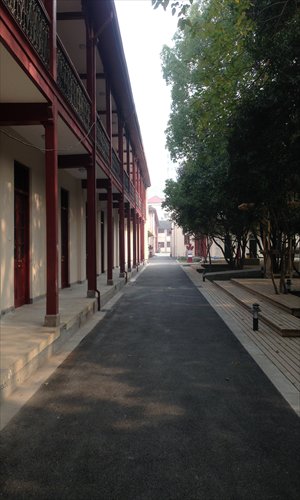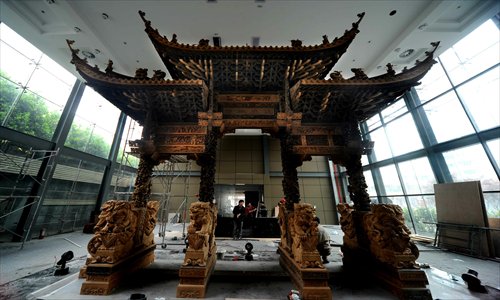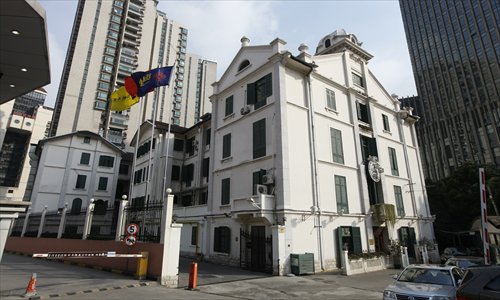A history of helping hands
Editor's note:
From a fishing village with a population of just 200,000 in 1843, Shanghai has developed into a huge modern city where more than 23 million people live. From the time Shanghai was forced to open up as a port in 1843, the city has witnessed remarkable change and progress. This year marks the 171st anniversary of Shanghai's opening-up and in this special series of reports, the Global Times will highlight some of the crucial moments, recall some choice memories of olden days and uncover some of the secrets of the city. Don't miss these exciting insights into the metropolis.
While Shanghai now boasts a plethora of organizations lending a helping hand to those in need, the origins of the city's charitable organizations can be traced back to the Ming Dynasty (1368-1644). According to historical records, the first charity house in the Shanghai region was opened in the year 1374 to take in homeless and disabled people.
However charitable institutions like this didn't truly flourish until Shanghai was forced to open up as a port in the 1840s. Sponsored by officials and landowners, these charities then played an active part in fundraising for the destitute, caring for the orphaned and the elderly, offering disaster relief, free food and shelter, free education, free medical consultations and funerals among many services. They also helped with road construction and civil defense.
Shanghai's charities continued to develop during the Republic of China period (1912-49). The Shanghai Municipal Charity Group, comprising the region's major charity organizations, was founded in October 1912 and was renamed the Shanghai Charity Group two years later. After another decade of assimilations, the Shanghai Federation of Charity Organizations came into existence in 1927 representing some 39 institutions.
By 1947 orphanages and nursing homes, public and private, accounted for a large number of the city's 114 charity organizations registered with the municipal government. Here are four of the noteworthy orphanages that thrived in Shanghai before 1949.

Xin Puyu Tang
The Xin Puyu Tang, the New Public Child-care Hall, was established by the Chinese entrepreneur-turned-philanthropist Lu Bohong in 1911, shortly after the Xinhai Revolution that led to the end of the Qing Dynasty (1644-1911). Nestled on today's Puyu Road West, a back street off bustling Lujiabang Road in Huangpu district, the Xin Puyu Tang was converted from the original Puyu Tang, a home for the disabled and the terminally ill.
Covering 52,000 square meters, the Xin Puyu Tang was not only designed to take in orphaned and destitute children in Shanghai, but also the needy, the disabled and the ill. Run by Catholic nuns, the institution accepted more than 6,000 people in its first year of opening, four times the capacity that it was designed to handle.
Although the Xin Puyu Tang became one of the largest charity organizations in the Far East during the 1920s and 1930s, it had a high infant mortality rate because of a lack of funding and poor management. The situation grew worse after the death of Lu Bohong in 1937 when he was murdered by two unidentified assassins.
The Shanghai Municipal Government took over the Xin Puyu Tang shortly after the founding of the People's Republic of China in 1949 and it was turned into the Shanghai Children's Welfare Institute in 1956. The institute - the city's first municipal orphanage after the founding of new China - moved to a larger facility in Minhang district in 2001.
Today the site of the original Xin Puyu Tang is home to Gongyi Xintiandi, a new government-funded hub for NGOs and social enterprises. Aiming to build a creative and well-equipped environment where social entrepreneurs in Shanghai can gather to work, communicate, learn from each other, and strengthen networking, the Shanghai Civil Affairs Bureau injected some 50 million yuan ($8.24 million) into the restoration of the site's historical buildings and infrastructure for the new park.
The Shanghai Orphanage
The Shanghai Orphanage was opened in the early 1920s by Zhejiang entrepreneur Wang Yiting, who was also a well-known artist at that time. Built in today's Longhua region in Minhang district, the orphanage was first named the Longhua Orphanage. It was renamed the Shanghai Orphanage in 1927 when more buildings were erected and more orphans accepted. At its peak, the orphanage accommodated more than 500 children and nearly 100 staff.
The institute segregated its boys and girls, all of whom would receive six years of basic education. From 1930, the orphanage also gave trade courses on weekday afternoons. Boys studied carpentry, shoemaking, bamboo and rattan handicrafts at the workshops while girls were taught dressmaking, embroidery and cooking. Many of the handmade products fashioned by the orphans became sought-after items during the annual Longhua Temple fair - the temple was only a stone's throw away from the orphanage.
Apart from the trade courses that were given to the orphans to prepare them for the future, the orphanage also hired teachers to give music lessons. It later formed a band with more than 100 orphan musicians who could play for weddings and funerals and other public events.
The happiest time of the year at the orphanage was Christmas. Because missionaries were key founders of the orphanage, Christianity was a major influence on the lives of the children and staff. All of the Shanghai Orphanage children were told to pray in the mornings and evenings, and had to attend services every Sunday - even though Wang Yiting, the orphanage's founder, was a Buddhist. Christmas was celebrated with holidays, theatrical and musical performances, and parties attended by some of the city's socialites, especially the ones who had given generous donations to the orphanage.
After the outbreak of the War of Resistance against Japanese Aggression in 1937, most of the orphanage's buildings were destroyed by bombing and many of its benefactors fled Shanghai. The Shanghai Orphanage fell into disuse prior to the victory in the War of Resistance in 1945. The original site of the orphanage is now home to a printing plant on today's Longhua Road.

Tushanwan Orphanage
Tucked away down the south of Xujiahui, the Tushanwan Orphanage was founded by Jesuit missionaries in Shanghai in 1864. What made this orphanage different from other charitable homes was that it not only provided its children with food and lodging, but also offered training in various trades and especially in arts and crafts.
In its workshops presided over by teachers from Europe, the orphanage birthed hundreds of Western-style artists, painters, sculptors and photographers. The roll call of noted artists included Zhou Xiang (1871-1933), Ding Song (1891-1972), Xu Yongqing (1880-1953), Hang Zhiying (1899-1947) and the sculptor and painter Zhang Chongren (1907-98) who was famed in his own right and as a collaborator and close friend of the Belgian Tintin creator Hergé.
The orphanage became so famous that some local parents tried using friends with influence to have their children admitted. The orphanage cared for more than 2,000 orphans from 1864 to 1903.
After 1949 the orphanage declined and the Shanghai Civil Affairs Bureau took over the administration of the 200 or so remaining orphans. The school's once flourishing workshops and presses were merged into State-owned companies.
The only Tushanwan building still standing today is a three-story red-brick house on Puhuitang Road. Once the former main school building for the orphanage, the house is now part of the Tou-Se-We Museum where more than 1,000 exhibits including photographs and works of art created by Tushanwan orphans are on display.

Notre Dame of Zi Ka Wei
On the eastern side of Zhaojiabang in Xujiahui stands an imposing five-story whitewashed building, which used to be the Notre Dame of Zi Ka Wei (Xujiahui). Built in the late Qing Dynasty, the house was home to the French Salvation Association in Shanghai, which opened an orphanage in 1869.
This orphanage mostly cared for girls under 5 years. They were looked after by governesses and were taught Chinese, mathematics, history, geography and calligraphy from the age of 6 or 7. They also learned silk embroidery, tailoring, cooking, laundering and gardening.
As one of the largest orphanages in old Shanghai, the orphanage affiliated to the Notre Dame of Zi Ka Wei looked after more than 10,000 orphans in its near 80-year history, before it was taken over by the city's Civil Affairs Bureau after the country's liberation.
However, the high turnover also reflected a high mortality rate in a time when medical treatments were poor or lacking altogether. The remains of thousands of infants were discovered in a cemetery inside the convent, media reported in the 1950s, a scandal that resonated throughout the city.
Today the original site of the Notre Dame of Zi Ka Wei on Caoxi Road North has given way to posh shopping malls and sprawling high-rise buildings, with the five-story building home to a restaurant which serves Shanghai cuisine.